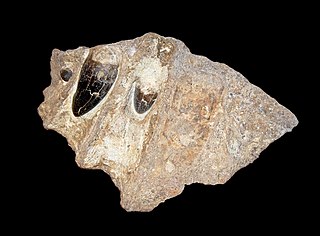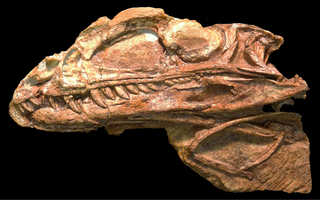
Goniopholis is an extinct genus of goniopholidid crocodyliform that lived in Europe and North America during the Late Jurassic and Early Cretaceous. Like other goniopholidids, it resembled living crocodilians, and probably had a similar ecology as semi-aquatic ambush predators.

Razanandrongobe is a genus of carnivorous ziphosuchian crocodyliform from the Middle Jurassic of Madagascar. It contains the type and only species Razanandrongobe sakalavae, named in 2004 by Simone Maganuco and colleagues based on isolated bones found in 2003. The remains, which included a fragment of maxilla and teeth, originated from the Bathonian-aged Sakaraha Formation of Mahajanga, Madagascar. While they clearly belonged to a member of the Archosauria, Maganuco and colleagues refrained from assigning the genus to a specific group because the fragmentary remains resembled lineages among both the theropod dinosaurs and crocodylomorphs.
Rugosuchus is an extinct genus of neosuchian crocodyliform from the late Early Cretaceous of China. It is known from most of a skull, a partial postcranial skeleton, and a second partial skeleton including part of the hips. It was described by Xiao-Chun Wu and colleagues in 2001, with R. nonganensis as the type species. At the time of its description, it was the most complete crocodyliform from northeastern China, and only the second known.

Goniopholididae is an extinct family of moderate-sized semi-aquatic neosuchian crocodyliformes. Their bodyplan and morphology are convergent on living crocodilians. They lived across Laurasia between the Middle Jurassic and the Late Cretaceous.

Eutretauranosuchus is an extinct genus of goniopholidid crocodyliform. E. delfsi is the only known species within the genus.

Neosuchia is a clade within Mesoeucrocodylia that includes all modern extant crocodilians and their closest fossil relatives. It is defined as the most inclusive clade containing all crocodylomorphs more closely related to Crocodylus niloticus than to Notosuchus terrestris. Members of Neosuchia generally share a crocodilian-like bodyform adapted to freshwater aquatic life, as opposed to the terrestrial habits of more basal crocodylomorph groups. The earliest neosuchian is suggested to be the Early Jurassic Calsoyasuchus, which lived during the Sinemurian and Pliensbachian stages in North America. It is often identified as a member of Goniopholididae, though this is disputed, and the taxon may lie outside Neosuchia, which places the earliest records of the group in the Middle Jurassic.

Amphicotylus is an extinct genus of goniopholidid mesoeucrocodylian from the Tithonian of Colorado, Wyoming, and Oklahoma. It was described in 1878.
Kayentasuchus is a genus of sphenosuchian, a type of basal crocodylomorph, the clade that comprises the crocodilians and their closest kin. It is known from a single skeleton found in rocks of the Sinemurian-Pliensbachian-age Lower Jurassic Kayenta Formation, northeastern Arizona.
Kayentachelys is an extinct genus of turtle known only from the "silty facies" of the Lower Jurassic Kayenta Formation in northeastern Arizona on the lands of the Navajo Nation.
Shartegosuchidae is an extinct family of Late Jurassic and Early Cretaceous crocodyliforms. The family is named after the Late Jurassic Shar Teeg Beds in southwestern Mongolia, from which most shartegosuchid remains have been found. Five genera are currently assigned to Shartegosuchidae: Shartegosuchus, Nominosuchus, Kyasuchus, Adzhosuchus, and Fruitachampsa. Shartegosuchus, Nominosuchus, and Adzhosuchus all come from Shar Teeg, while Kyasuchus is known from the Early Cretaceous of Russia. Fruitachampsa is known from the Late Jurassic Morrison Formation of the western United States.
Sunosuchus is an extinct genus of goniopholidid mesoeucrocodylian. Fossils are known from China, Kyrgyzstan, and Thailand and are Jurassic in age, although some may be Early Cretaceous. Four species are currently assigned to the genus: the type species S. miaoi and the species S. junggarensis, S. shartegensis, and S. shunanensis. All species are from China. Goniopholis phuwiangensis, also from Thailand, was reassigned to Sunosuchus by Andrade et al. (2011). The material from Kyrgyzstan has not been assigned to any species.
Shantungosuchus is an extinct genus of Early Cretaceous crocodyliform found in China. It includes three species: Shantungosuchus chuhsienensis and S. brachycephalus, which were both described by Yang Zhongjian – usually referred to as "Young" – in 1961 and 1982, and S. hangjinensis, which was described by Xiao-Chun Wu et al in 1994. S. chuhsienensis is the type for this genus.

Sarahsaurus is a genus of basal sauropodomorph dinosaur which lived during the Early Jurassic period in what is now northeastern Arizona, United States.
Anteophthalmosuchus is an extinct genus of goniopholidid mesoeucrocodylian from the Early Cretaceous of southern England, eastern Spain, and western Belgium.
Hulkepholis is an extinct genus of goniopholidid mesoeucrocodylian from the Early Cretaceous of southern England and eastern Spain. It contains two species, the type species, Hulkepholis willetti, and also H. plotos. Hulkepholis is most closely related to both species of Anteophthalmosuchus.

Chalawan is an extinct genus of pholidosaurid mesoeucrocodylian known from the Late Jurassic or Early Cretaceous Phu Kradung Formation of Nong Bua Lamphu Province, northeastern Thailand. It contains a single species, Chalawan thailandicus, with Chalawan shartegensis as a possible second species.

Coelophysis? kayentakatae is an extinct species of neotheropod dinosaur that lived approximately 200–196 million years ago during the early part of the Jurassic Period in what is now the southwestern United States. It was originally named Syntarsus kayentakatae, but the genus Syntarsus was found to be preoccupied by a Colydiine beetle, so it was moved to the genus Megapnosaurus, and then to Coelophysis. A recent reassessment suggests that this species may require a new genus name.

Coelognathosuchia is an extinct clade of neosuchian crocodyliforms that includes all taxa more closely related to the family Pholidosauridae than to Bernissartia fagesii or Eusuchia. Martin et al. (2014) named the clade after finding goniopholidids and pholidosaurids to group together in their phylogenetic analysis of crocodyliform evolutionary relationships. In their analysis, Pholidosauridae was monophyletic and Goniopholididae was paraphyletic, being an assemblage of successively more basal taxa within Coelognathosuchia. Coelognathosuchia itself was positioned near the base of the larger clade Neosuchia as the sister group to a clade containing the Early Cretaceous neosuchian Bernissartia and Eusuchia, the group that includes all modern crocodilians and their closest extinct relatives.

Turnersuchus is an extinct genus of thalattosuchian, a group of marine crocodylomorphs, from the Pliensbachian of the United Kingdom. It is the oldest diagnostic member of Thalattosuchia and was also found to be the group's most basal member, being situated outside the two major groups Metriorhynchoidea and Teleosauroidea. Subsequently, this genus is considered to be of great importance to understanding the relationship between thalattosuchians and other crocodylomorphs as well as their rapid diversification during the early Jurassic. Turnersuchus is a monotypic genus, meaning it includes only a single species, Turnersuchus hingleyae.
Ophiussasuchus is an extinct genus of goniopholid neosuchian from the Upper Jurassic Lourinhã Formation of Portugal. It was a medium-sized goniopholid, about 2.5 m to 3 m long, with a flattened skull and mesorostrine snout. Although most closely related to the Cretaceous goniopholids of Europe, such as Hulkepholis and Anteophthalmosuchus, Ophiussasuchus shares a variety of characteristics with more basal taxa from the Jurassic of Asia and North America. This could suggest that it either represents a transitional form or that this genus independently re-evolved these ancestral features. Ophiussasuchus is a monotypic genus, only including a single species: O. paimogonectes.












